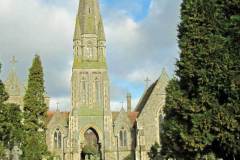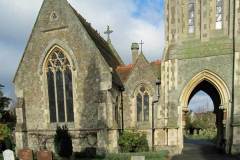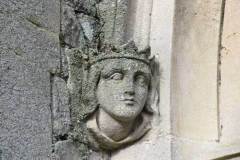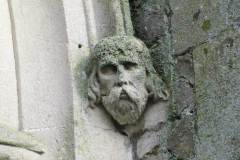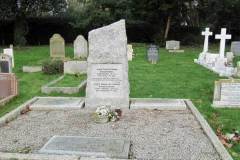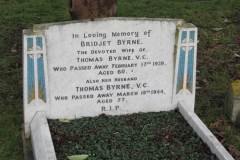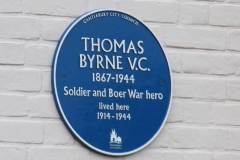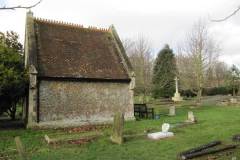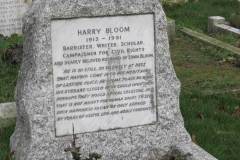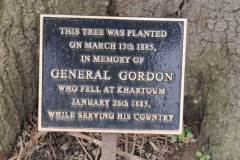Main Entrance off Westgate Court Avenue
You can enter Canterbury City Cemetery from either the main gate on Westgate Court Road or from a rear entrance in Cherry Garden Road (off Whitstable Road). Opened on 4 July 1877, its main building is a double chapel and spire – at 110 ft perhaps the only real spire in the city (Image 1 and 2). For the architect, John Green Hall (1835-1887), who lived in St Margaret’s Street, this was a busy time. He was also responsible for the RC church in Burgate (1875) and the Congregational church in Guildhall (1877), and worked as City Surveyor and Architect. The cemetery covered 12 acres and cost £9000, with a further 8 acres added in 1923. The chapels are faced with rag stone with Bath stone dressings. Small stone heads greet you at the entry between the chapels – maybe Ethelbert and Bertha (Images 3 and 4)?
Gravestones to see:
Note: individual graves are often hard to find – capital letters in square brackets denote the section of the cemetery where we know them (marked on the plan displayed at the entrance). Do let us know if you can help with locations we haven’t found:
- Joseph Conrad (1857-1924) the writer who was born in the Ukraine but became a British citizen and spent much of his later life living in Kent – a grade II listed monument (Image 5) but a shame the local sculptor got his name wrong (his middle name was Teodor not Teador) [N]
- Thomas Byrne VC (1866-1944) born in Dublin and won his VC aged 21 at the Battle of Omdurman, Sudan, in 1898 (Image 6). He fought later in the Boer War. Winston Churchill, a reporter in Sudan at the time of Omdurman, referred to Byrne as “The bravest man I have ever known”. According to the Kent Fallen web site, skin from Churchill’s chest was used to save Byrne’s life (we can’t vouch for this). He lived from 1914 to 1944 in Notley Street where his home is marked with a blue plaque (Image 7) [MJ]
- Cecil Northcote Parkinson (1909-1993) writer and famous for ‘Parkinson’s Law’ lived at 36 Harkness Drive 1988-1993
- Many war graves – counts vary but one estimates 146 World War I and a further 54 World War II including a group in section [XM]; also the standard Cross of Sacrifice (Image 8), with its bronze sword [V]
- ‘Unknown citizens’ of Canterbury whose remains were taken from the graveyard of St Mary Bredin churchyard after it was destroyed by enemy bombs in 1942
- Canterbury’s youngest World War II victim Kathleen Rosa Raines ‘killed by enemy action aged thirteen on 20 April 1941’ [XM]
- E J Stanford, R N Boy 2nd class (1903-1919) died HMS Impregnable, not a ship but the Devonport Training Establishment, age 16 years. He died in a major outbreak of Spanish influenza
- Harry Bloom (1913-1981) a South African journalist and writer who challenged the apartheid system and was exiled to UK in 1963, later becoming senior lecturer of law at Kent University (Image 9). He was the father of the internationally renowned wildlife photographerSteve Bloom; Harry Bloom’s second wife Sonia is mother of the successful actor Orlando Bloom
- Silver lime tree commemorating the death of Gordon of Khartoum – it is unclear who planted this and when. A funeral service was held in Canterbury (and every other) cathedral on 13 March 1885 (Image 10) [B]
Access: no restriction for pedestrian access
Sources: Brown (1990); Canterbury City Council web site re Blue Plaque scheme; Commonwealth War Graves Commission web site; Kent Fallen web site; population census returns
DL

